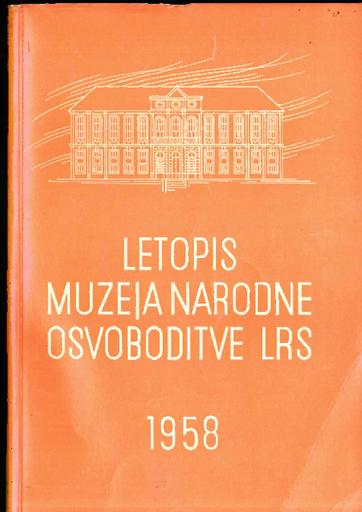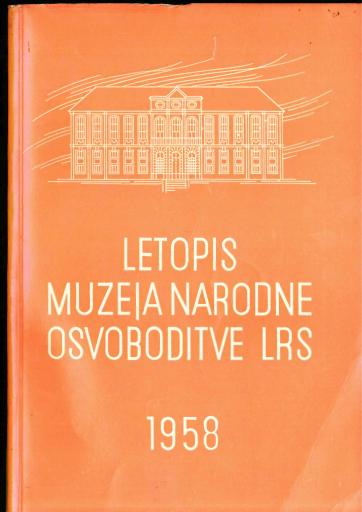/
Serijske publikacije
/
Prispevki za novejšo zgodovino
Wehrmannschaft v boju proti narodnoosvobodilni vojski na Štajerskem


To delo avtorja Tone Ferenc je ponujeno pod Creative Commons Priznanje avtorstva-Nekomercialno-Brez predelav 4.0 Mednarodna
Datoteke (1)

Opis
Namen sestavka je v grobih obrisih prikazati razvoj ene izmed vojsk s katerimi se je narodnoosvobodilna vojska spoprijemala v boju za nacionalno in socialno osvoboditev slovenskega ljudstva. To je prvi tovrsten pregled razvoja Wehrmannschafta na Štajerskem in ima svoje pomanjkljivosti, ker je arhivsko gradivo ohranjeno le v manjši meri oziroma meni nedostopno. Kljub temu pa upam, da se mi je vendarle posrečilo, iz več sto med seboj ločenih podatkov sestaviti zaključeni pregled in prikazati, kako morajo nacisti pod pritiskom osvobodilnega gibanja uporabljati Wehrmannschaft v druge namene kot je bil ustanovljen, njegove oblike organiziranja za boj proti osvobodilni vojski, njegovo kakovost, zlom itd.
Metapodatki (12)
- identifikatorhttps://hdl.handle.net/11686/4589
- naslov
- Wehrmannschaft v boju proti narodnoosvobodilni vojski na Štajerskem
- The German »Wehrmannschaft« and Their Struggle Against the Partisan Forces in Styria
- ustvarjalec
- Tone Ferenc
- soavtor
- Milan Bevc (odg. ur.)
- predmet
- Wehrmannschaft
- Štajerska domovinska zveza - Steirischer Heimatbund
- slovenska zgodovina
- druga svetovna vojna
- nemška okupacija
- NOB
- vojaška zgodovina
- Wehrmannschaft
- Styria Homeland Association - Steirischer Heimatbund
- Slovenian History
- Second World War
- German Occupation
- National Liberation War
- Military History
- opis
- After the occupation of Lower Styria in mid April 1941 the Germans established an organization similar to the National Socialist German Workers'Party, called »Steirischer Heimatbund« (Styrian Patriotic League), with the view of schooling the Lower Styrian population to their imminent annexation to the so-called Greater German Reich. After certain Nazi measures for the behoof of »the consolidation of Teutonism« in Lower Styria (deportation of »alien elements« and confinement of »dangerous persons«), and in view of the vigorous' Nazi demagogy, about 95 o/o of the population joined the Heimatbund. All the male inhabitants between their 18th and 45th year, accepted as members of the Heimatbund, belonged automatically to the Wehrmannschaft. The basic task of these troops was the same as that of the S. A. (Stormtroops), i. e. premilitary training seasoned with political instruction in true Nazi spirit. They were also organized quite analogously to the S. A., put under the control of the S. A.-Group »Sudmark« (South March) in Graz, and commanded by the leader of the Wehrmannschaft: this was up to mid 1943 the S. A. Standartenfuhrer Blasch, and afterwards the leader of the Styrian Patriotic League himself, S. A. Oberführer Franz Steindl. Each district had one or two »Standarten« (regiments): the districts Ljutomer, Maribor Town, Brežice, Trbovlje each one, and the districts Maribor-Country, Ptuj and Celje each two. Each Standarte had several »Sturms« (companies), i.e. basical military instructional units, which used to comprise 150—200 men of the same place. The organization was achieved in late autumn, 1941, when there were 10 »Standarten« with 307 »Sturms« and 84.700 men. But even prior to the gathering up of the men fit for service in the »Wehrmannschaft«, the Nazis had been forced by the activity of the first Styrian partisans as early as in summer, 1941, to employ the Wehrmannschaft for actions against the partisans, viz in August for the pursuit of the Pohorje company, and then in the Celje district where the 1st Syrian battalion was operating, formed of the Pohorje, Savinja and Mining-District Companies in early October, 1941. In each Sturm about ten men were armed to compose »Special Groups« (Sondergruppen), which were at any time at the command of the several police-stations; with a view to help the police to pursue the Styrian battalion, they were occasionally combined in larger detachments (Oct. 8th and 26th, Nov. 1st, 1941). After (in early Nov., 1941) the Battalion had divided into smaller units to hibernate in various places, and stronger partisan activities in Lower Styria had ceased for a while, the Wehrmannschaft was — up to the spring of 1942 — likewise no more used to fight the partisans back. In order to shield Lower Styria against influences from the Province of Ljubljana and Gorenjska, where the struggle for liberation was then brisker, the Germans established (April 14th, 1942) the »Wehrmannschaftsbataillon Süd« (with 6 companies) and marched it to the frontier: 4 companies between Krmelj and Raka, 2 platoons to the provincial border between Styria and Gorenjska, and 4 platoons into the Celje district. After the partisan 2nd Group of Detachments had been repelled near Janče (May 19th—21st) and when the reorganized 1st Syrian battalion had reopened its activity, the German battalion was reinforced with 3 companies in late May and early June, 1942, and gradually shifted to the north of the Trbovlje and the west of the Celje districts. But there were no essential gains, and even the Germans admitted the negative outcome of all encounters and skirmishes. Even before the arrival of the 2nd Group of Detachments in Lower Styria the Germans were forced to bring new police forces there and include part of the district Maribor Country into the operational area.
- Namen sestavka je v grobih obrisih prikazati razvoj ene izmed vojsk s katerimi se je narodnoosvobodilna vojska spoprijemala v boju za nacionalno in socialno osvoboditev slovenskega ljudstva. To je prvi tovrsten pregled razvoja Wehrmannschafta na Štajerskem in ima svoje pomanjkljivosti, ker je arhivsko gradivo ohranjeno le v manjši meri oziroma meni nedostopno. Kljub temu pa upam, da se mi je vendarle posrečilo, iz več sto med seboj ločenih podatkov sestaviti zaključeni pregled in prikazati, kako morajo nacisti pod pritiskom osvobodilnega gibanja uporabljati Wehrmannschaft v druge namene kot je bil ustanovljen, njegove oblike organiziranja za boj proti osvobodilni vojski, njegovo kakovost, zlom itd.
- založnik
- Muzej narodne osvoboditve LRS
- datum
- 1958
- tip
- besedilo
- jezik
- Slovenščina
- jeDelOd
- pravice
- licenca: ccByNcNd
